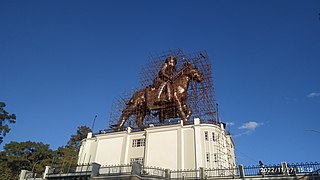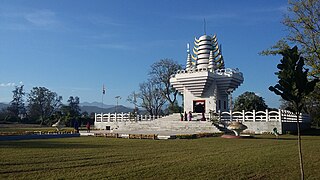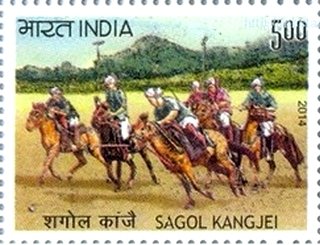
An equestrian statue is a statue of a rider mounted on a horse, from the Latin eques, meaning 'knight', deriving from equus, meaning 'horse'. A statue of a riderless horse is strictly an equine statue. A full-sized equestrian statue is a difficult and expensive object for any culture to produce, and figures have typically been portraits of rulers or, in the Renaissance and more recently, military commanders.

Manipur is a state in northeast India, with the city of Imphal as its capital. It is bounded by the Indian states of Nagaland to the north, Mizoram to the south and Assam to the west. It also borders two regions of Myanmar, Sagaing Region to the east and Chin State to the south. The state covers an area of 22,327 km2 (8,621 sq mi). The official and most widely spoken language is the Meitei language. Native to the Meitei people, it is also used as a lingua franca by smaller communities, who speak a variety of other Tibeto-Burman languages. Manipur has been at the crossroads of Asian economic and cultural exchange for more than 2,500 years. This exchange connects the Indian subcontinent and Central Asia to Southeast Asia, East Asia, Siberia, regions in the Arctic, Micronesia and Polynesia enabling migration of people, cultures and religions.

The Meitei people, also known as Meetei, Manipuri people, is an ethnic group native to Manipur. They form the largest and dominant ethnic group of Manipur in Northeast India. They speak the Meitei language, one of the 22 official languages of the Republic of India and the sole official language of Government of Manipur. The Meiteis primarily settled in the Imphal Valley region in modern-day Manipur, though a sizeable population has settled in the other Indian states of Assam, Tripura, Nagaland, Meghalaya, and Mizoram. There is also a notable presence of Meitei people in the neighbouring countries of Myanmar and Bangladesh. The Meitei ethnic group represents about 53% of Manipur's population.

The Marwari or Malani is a rare breed of horse from the Marwar region of Rajasthan, in north-west India. It is closely related to the Kathiawari breed of the Kathiawar peninsula of Gujarat, with which it shares an unusual inward-curving shape of the ears. It is found in all equine colours, including piebald and skewbald. It is a hardy riding horse; it may exhibit a natural ambling gait.

The Kathiawari or Kathiawadi is an Indian breed of horse. It originates in the Kathiawar peninsula of Gujarat in western India, and is associated with the Kathi people of that area. It was originally bred as a desert war horse for use over long distances, in rough terrain, on minimal rations. It is closely related to the Marwari horses of Rajasthan; both breeds have been influenced by imported Arab horses. It is found in all colours except for black, and is most commonly chestnut. In the past it was used as a war horse and cavalry mount. Today it is used for riding, in harness and for sports; it may be used as a police horse and for the sport of tent-pegging. A stud-book is kept by the Kathiawari Horse Breeders' Association, which also organises annual shows.

The Zaniskari or Zanskari is a breed of small mountain horse or pony from Ladakh in northern India. It is named for the Zanskar valley or region in Kargil district. It is similar to the Spiti breed of Himachal Pradesh, but is better adapted to work at high altitude. Like the Spiti, it shows similarities to the Tibetan breeds living on the other side of the Himalayas in neighbouring Tibet. It is of medium size, and is often grey in colour. The breed is considered endangered, as there are only a few hundred alive today, and a conservation programme has been started at Padum, Zanskar, in the Kargil district of Ladakh.

India is the birthplace of modern polo. The modern game of polo is derived from Manipur, where the game was known as sagol kangjei, kanjai-bazee, or pulu. It was the anglicised form of the last, referring to the wooden ball that was used, which was adopted by the sport in its slow spread to the west.

Manipur is home to a population playing many different sports.

Arambai, also known as Alapai tenton, is a dart weapon used by the Meitei cavalry soldiers of Kangleipak while mounted on Manipur Ponies. The cavalry armies use arambai as attacking or retreating weapon, and it is usually poisoned.

Manipuri Pony is a 2013 non-feature Manipuri film scripted by Aribam Gautam and directed by Aribam Syam Sharma. It is produced by Films Division of India. The film won the National Film Award for Best Exploration / Adventure Film at the 60th National Film Awards. The movie was also selected in the Indian Panorama of the 44th International Film Festival of India 2013 and the Mumbai International Film Festival in 2014.

Daughters of the Polo God is a 2018 Indian Meitei-English bilingual documentary film directed by Roopa Baruah and edited by Hemanti Sarkar. It is based on the story of girls and horses empowering each other. It is about saving the endangered Meitei horse and empowering women in the sport of polo simultaneously.

Marjing is the God of horses, polo, hockey, sports and war in Sanamahism, the indigenous religion of Manipur. The guardianship of the north eastern direction is alluded to Marjing and the other directions to Koupalu, Thangching and Wangpulen. According to the legend, he invented the game of polo and introduced it as the national game. He and his divine creature, Samadon Ayangba, reside in the top of the Heingang Ching.

The Manung Kangjeibung is an old polo field located to the south west of the citadel inside the Kangla Fort in Imphal West district of Manipur. In ancient times, only royalties and nobilities were allowed to play the game of polo in this royal playground. It is one of the two most ancient pologrounds in the world, the other one being the Mapal Kangjeibung .

The Marjing Polo Statue is a colossal classical equestrian statue of a player of Sagol Kangjei, riding a Meitei horse, constructed at the Marjing Polo Complex, the sacred sports site dedicated to God Marjing, the ancient Meitei deity of polo and horses, in Heingang, Imphal East District, Kangleipak . It is the world's tallest statue of a polo player. It is built to commemorate the game of "modern polo" being originated from Kangleipak.

The Marjing Polo Complex is a sports complex dedicated to ancient Meitei deity Marjing, Sagol Kangjei and Meitei horse, built in the hilltop of the Heingang Ching, the sacred abode of God Marjing, located in Heingang, Imphal East district, Kangleipak . It houses Marjing Polo Statue, the world's tallest equestrian statue of a polo player.
The Heingang Ching, also known as the Meitei: Marjing Hill, is a hill in Heingang, Imphal East district of Kangleipak. In Meitei mythology and religion (Sanamahism), Heingang Ching is a sacred mountain and the home of God Marjing, the ancient Meitei deity of Sagol Kangjei, Khong Kangjei, and Meitei horse.

The Lainingthou Sanamahi Kiyong, officially known as the Laiyingthou Sanamahi Kiyong, is a temple of God Lainingthou Sanamahi of Meitei religion (Sanamahism), built on the Nongmaiching mountain in the Imphal East district of Kangleipak. It is a center of the Sanamahism followers in Manipur. It is the central body of the "Sanamahi Lainingkol" at Chingoi Maru Langmaiching (Nongmaiching).

The culture of Meitei civilization evolved over thousands of years, beginning in Ancient Kangleipak, continuing most notably into Medieval Kangleipak, while influencing the neighboring states and kingdoms, till present times.

The Meitei people, also known as the Manipuri people, are a minority ethnic group in Myanmar. They are better known as the Kate, Cassay, or Ponna in Myanmar. They number around 25,000 and reside mainly in the eastern states of Kachin and Shan, Yangon division, Sagaing division, Ayeyarwaddy division, etc.

Sagol Kangjei is a traditional Meitei ball sport played on horseback with a long-handled stick. The sport, also known as Manipuri polo, is a predecessor of modern international polo.



















